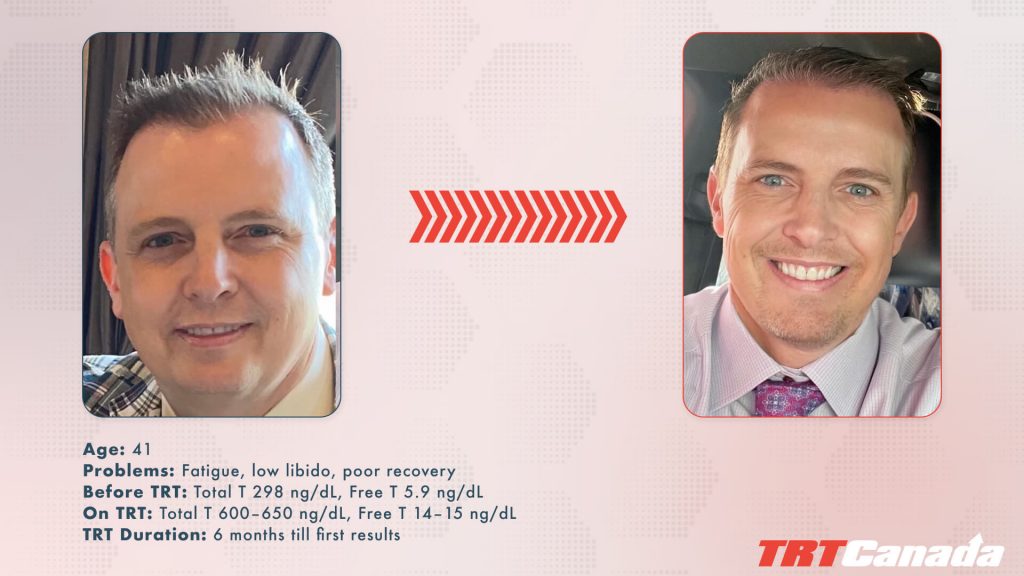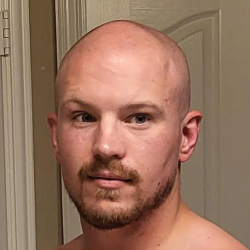
John Campbell, a 41-years old manager, has always thought of himself as a success-driven individual, a go-getter, as some would say. He was living what many would call the dream: a stable career, a loving wife, two beautiful children and his own house in a friendly suburban neighborhood.
Yet, beneath this white-picket-fence facade, John felt trapped, battling chronic fatigue, stress, mental fog and dissatisfaction with the lifestyle he had to lead. The pressures of meeting sales targets, the demands of his manager position and family obligations left him with little to no time or energy for exercising.
When John Campbell finally decided to seek professional help, a thorough blood panel revealed a diagnosis that changed his life trajectory: clinically low testosterone levels. Eager to return to his younger self, John turned to TRT Canada, a clinic, specialising in testosterone replacement therapy. That’s when his story took a new turn.
About Early Warning Signs: John’s Path to the Diagnosis
By the time John was 41, he was struggling with more than just being stressed from work. Each day ended with him “crashing” on the couch, too drained to engage with his kids or enjoy a short walk. Weekends became his recovery time from the prior week, he couldn’t savor some family time.
“Honestly, I felt like I was in my late 70s. I’d wake up tired, push through coffee after coffee, and then collapse in the late afternoon. I had zero motivation for hobbies, I could barely keep my eyes open after lunch. It got so bad that I couldn’t concentrate on anything, and I was always on edge.”
At first, he dismissed these symptoms as the inevitable result of aging and a high-pressure job. After all, who hadn’t experienced fatigue and irritability? However, the feeling that something deeper was amiss never left him.
John’s wife has encouraged him to seek medical advice to rule out any underlying conditions. Eventually, a comprehensive blood panel ordered by his primary doctor laid bare the root cause: his testosterone levels were significantly below the optimal range. For a man in his early 40s, this was certainly not unheard of, yet it was a red flag that demanded attention.
Bloodwork and Diagnosing Process: John’s Initial Lab Results
John’s first appointment at TRT Canada began with an in-depth consultation and comprehensive blood tests. His initial numbers were telling:
- Total Testosterone: 245 ng/dL;
- Free Testosterone: 6.2 ng/dL;
- SHBG (Sex Hormone-Binding Globulin): 58 nmol/L;
- Estradiol (E2): 12 pg/mL;
- RBC and Hematocrit: Within normal reference range.
From these figures, it was clear that John’s symptoms could indeed be linked to suboptimal testosterone. The elevated SHBG explained why, even if his total T was borderline, his free T was particularly low — a classic sign that he wasn’t getting enough “active” hormone.
At the same time, his E2 levels were on the lower side, possibly causing mood issues. Even though his RBC and Hematocrit were within normal reference range, they were noted as worth monitoring.
Other results indicated moderate levels of stress hormones and slightly elevated cholesterol. John’s physician at TRT Canada noted that chronic stress, lack of exercise, and an over-reliance on caffeine can all exacerbate low testosterone symptoms.
Those numbers were all John needed to realize he had to take action. Yet the big question remained: How should he address his low testosterone levels safely and effectively?
TRT Canada’s Recommendations
Once the team had confirmed that John’s testosterone level was indeed below the optimal range for his age, they suggested a personalized treatment plan. Given his borderline levels and relatively high SHBG, the medical team proposed a cautious yet consistent approach:
- Medication: A long-acting testosterone ester (e.g., Testosterone Cypionate);
- Dose: Minimal effective dose of 100 mg/week, split into two injections for stable levels;
- Additionals: Vitamin D and zinc, given moderate deficiencies revealed by blood tests;
- Ongoing monitoring of hormone levels (including regular blood work);
- Lifestyle advice on stress management and light exercise;
- Periodic adjustments to medication based on blood test results.
TRT Canada’s medical experts emphasized realistic expectations: TRT would likely help stabilize John’s energy and mood, but wouldn’t magically eliminate work stress or transform him overnight into an endurance athlete.
Continuous Support
John appreciated how TRT Canada provided detailed instructions, follow-up appointments, and open communication channels. Whenever he had a question — whether about injection technique, scheduling blood tests, or discussing side effects — he had a responsive team ready to help.
“They really held my hand through everything. I had no clue about dosage, needles, or what to expect, but they made it simple. They shipped everything I needed, along with super-clear instructions. They didn’t just hand me a prescription. They coached me on making doable changes that would support the therapy. That’s what made the biggest difference”
We maintained regular touchpoints as well:
- Monthly Checks: To address any concerns, tweak dosages if required, and discuss side effects (if any)
- Quarterly Blood Tests: To monitor testosterone, estradiol, RBC count, and other relevant markers
- Lifestyle Coaching: Suggestions for diet, exercise, and stress management to maximize TRT benefits.
Lifestyle Adjustments
TRT Canada team had also encouraged small, sustainable habit changes, such as:
- Two 30-minute strength training sessions weekly, one moderate-intensity cardio session (e.g., brisk walking or cycling);
- More lean protein sources (chicken, fish, or legumes), reduced processed sugar and refined carbohydrates
- Simple mindfulness techniques, cutting back on stimulants after lunchtime.
Progress and Ongoing Results: Was It Worth It
First Six Months on TRT
By the three-month mark, John’s fatigue started to lift. Although he was still tackling the same daily challenges, the oppressive cloud of exhaustion had noticeably diminished. Instead of crashing every afternoon, he found a renewed ability to remain focused at work — and still have energy left for family activities in the evening.
Within the initial half-year, John reported subtle yet significant improvements:
- He stopped relying on multiple afternoon coffees and found himself active through the entire workday;
- While he still faced the same work challenges, John felt more resilient and less prone to anger outbursts;
- Frequent waking at night decreased, and mornings felt less daunting.
Updated Bloodwork at Six Months Point:
- Total Testosterone: 610 ng/dL;
- Free Testosterone: 13.5 ng/dL;
- SHBG: 45 nmol/L;
- Estradiol: 22 pg/mL;
- Hematocrit: Slightly increased but still within the safe range.
These numbers put John firmly in the mid-normal testosterone range. But what’s more telling is his subjective improvements. That’s how the changes started.
First Year on TRT
Around six to nine months in, blood tests showed John’s testosterone levels moving to a robust, healthy range — without overkills. His estradiol levels also stabilized, further improving mood and overall well-being.
With encouragement from TRT Canada, John added short resistance-training sessions to his week, which accelerated his muscle tone development and helped him lose some weight.
By the one-year mark, John started noticing other benefits:
- While not bodybuilder-level, he had regained a leaner physique, with more definition in his arms and shoulders;
- He could jog alongside his kids without feeling completely winded;
- A renewed interest in intimacy improved his relationship with his wife.
He also lowered his cholesterol by incorporating more balanced meals and maintaining regular exercise. A second performance review at work showed marked improvement; he felt more engaged, creative, and resilient under pressure.
“It’s not a miracle, but I feel like I’ve gotten back a decade or more of my life back. I’m not just grinding through work anymore — I’m actively participating in life. My wife and kids see the change in my attitude and energy, and so do I.”
Reflecting on the Progress
After nearly four years, John continues to work closely with the specialists at TRT Canada. He has established a bi-annual bloodwork schedule to track testosterone levels, estradiol balance, and overall metabolic health.
“TRT was about more than just hormones, really. It’s about me showing up at work, at home, and in my own life. I look back and can’t believe how long I lived feeling burned out — TRT has given me back my life. You can’t put a price on that.”
He acknowledges that the therapy is ongoing and requires diligence, but he firmly believes it has been worth the investment of both time and money.
John says he now actively promotes to his friends & colleagues the idea that feeling chronically tired, foggy, or moody is not an acceptable “new normal.” By addressing the root cause, rather than masking symptoms, he found a pathway to reclaim lost energy.
YOUR OWN JOURNEY TO HORMONAL BALANCE, OPTIMIZED PERFORMANCE AND PEAK PHYSIQUE CAN START NOW: WITH TRT CANADA







